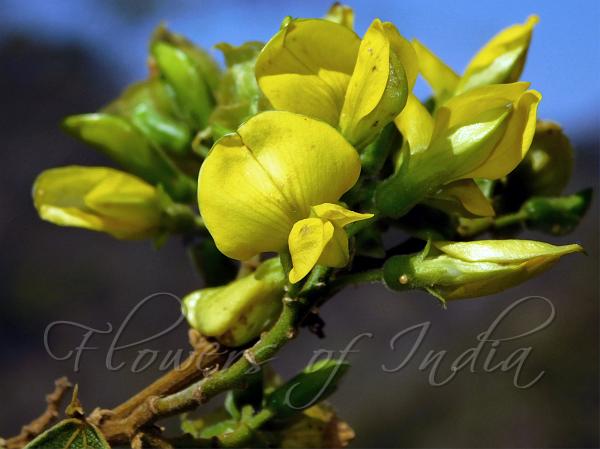|
| Himalayan Pigeonpea |
|

|

| File size | 596638 |
| Original date | 3/20/24 2:10 PM |
| Resolution | 4608 x 3456 |
| Flash | Flash fired |
| Focal length | 30.1mm |
| Exposure time | 1/400s |
| Aperture | 10.6 |
| Focus Distance | |
| Metering Mode | Multi-segment |
| Camera make | NIKON |
| Camera model | COOLPIX B500 |
| Sensor type |
|
|
|
|
Photo: |
Botanical name: Cajanus mollis Family: Fabaceae (Pea family)
Synonyms: Dolichos blandus, Cantharospermum molle, Atylosia mollis
Synonyms: Dolichos blandus, Cantharospermum molle, Atylosia mollis
Himalayan Pigeonpea is a twining perennial herb with
branches densely velvet-hairy. Leaves are almost digitately 3-foilate;
leaf-stalks 3-8 cm, leaflets ovate-elliptic or rombhic 4-7 x 2.5-6 cm,
pointed, base wedge-shaped, velvet-hairy especially beneath, glandular.
Flowers are borne in 6-15 flowered racemes, 5-7 bracts ovate 8-14 x
6-10 mm, falling off. Sepal-tube is 5 mm, teeth 3-5 mm. Petals are
yellow 1.3-2.5 cm, standard broadly oblong or obovate, 1.3-2.2 x
1.2-1.5 cm, wings elliptic, blade 10-17 x 4-5 mm with 2 ears at base,
the lower one short, the upper almost as long as basal claw, keel
oblong 10-16 x 5-6 mm, upcurved and rounded distally. Pods are 4-5 x
0.7-0.9 cm, rounded at tip, often bearing persistent style, densely
velvet-hairy, grooved almost at right angles at sutures, 6-9-seeded,
seeds oblong, brown or blackish 3.5-4 x 2.5-3 mm. Himalayan Pigeonpea
is is found in the Himalayas, from Pakistan to the Himalayas, to NE
India and China, at altitudes of 1100-1600 m. Flowering:
September-November.
| Identification credit: Nishant Chauhan | Photographed in Mandi, Himachal Pradesh. |
• Is this flower misidentified? If yes,